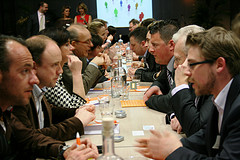 For decades, there is a strong emphasis on the management in procuring the welfare of the employee. And that well-being is to be achieved not only by physical conditions of the work place appropriate, but rather through a greater involvement of the workers in the organizations, and a greater freedom to exercise its work. “Happy workers are productive workers”, goes the saying.
For decades, there is a strong emphasis on the management in procuring the welfare of the employee. And that well-being is to be achieved not only by physical conditions of the work place appropriate, but rather through a greater involvement of the workers in the organizations, and a greater freedom to exercise its work. “Happy workers are productive workers”, goes the saying.
But it may be that the saying is only a myth without foundation. A study led by Stephen Wood, University of Leicester, has sought to determine whether the practices of management that seek to involve employees lead to higher levels of job satisfaction, which may translate to an increased performance of the organization.
The researchers were interested in the study of two concepts of management to contemporary are presented as means to achieve the participation of direct employees: the design of jobs enriched (enriched job design) and the management of high-involvement (High Involment Management, or HIM). What do you mean exactly with these concepts?
The design of jobs rich is oriented to the creation of high quality works, which allow employees greater autonomy in the performance of their functions, as well as greater flexibility in the establishment of routines for your task.
The HIM for his part looks at the participation of workers in the decision making processes of the organization, and therefore demand a higher pro-activity, flexibility and collaboration on the part of the employees. The HIM may be manifested by practices direct, as the work of a team or description flexible jobs, or indirect, through the dissemination of information or specific training.
Both the design of job as HIM have been associated with an increase in employee well-being: it is assumed that the increase of the autonomy, and the opportunity to generate ideas and make suggestions to the command posts increase the personal fulfillment and provide a sense of the work activity. Even so, there are few studies showing what is the real relationship between these practices of management, job satisfaction and the performance of organizations.
Thus, the team sought to clarify this issue, and for this purpose, he used the survey of UK’s Workplace Employment Relations Survey 2004. With this, disposing of data 14.127 employees, at 1,177 jobs, a large sample for this type of studies. The statistical analysis of the data revealed that:
The design of seats is related positively with productivity, economic performance, the quality of the work and the satisfaction laboral.
As the design of jobs, the HIM was related positively with productivity, the economic performance of the organization, and the quality of the work. But the analysis also showed that the HIM could be a source of dissatisfaction and anxiety on the job. In fact, the negative effect of HIM on job satisfaction may reduce the beneficial effect of HIM on the performance of the organization.
To put it more crudely: the managers who encourage employees to be more proactive and flexible get improvements in productivity, but at the cost of decreasing the job satisfaction of the employees.
What explains these results? According to the authors, the HIM represents a qualitative change, and not only quantitative, in the demands of the managers towards the employees: you have to think differently, be proactive, communicative, innovative,… These requirements covert may be the cause of anxiety and dissatisfaction, for at least four reasons:
In the first place, because the use of HIM can come accompanied by measures that push the employees to improve their results in the involvement of the organization is concerned (recall the indirect and direct methods of implantation of the HIM of which we spoke above). These measures may arouse concerns in the employees about their skills, the nature of their relationships with the other, and its psychological security.
In the second place, the HIM can increase the obligations received by the worker and, in doing so, reduce the sense of self-determination and independence in the job itself that manages to create the design of jobs enriched.
In the third place, the psychological states associated with the HIM can be connected with the political and economic context more broad in which we live: the employees may feel trapped in an environment in which they are pressured to be innovative, but at the same time do not possess the necessary conditions to foster innovation. As already commented in a previous post, the discourses on change and innovation that drive the organization can help mitigate or lessen this feeling is contradictory.
In addition, this contradiction between what is expected and what is actually offered by the organizations can lead employees to question the value that the organization attributed to them, and the significance of the environment in which they work.
Finally, the HIM can be perceived as a stress factor, a feeling that, once again, that it manages to mitigate the design of jobs, to enable greater independence in tasks.
Credits:
Image of Voka – Kamer van Koophandel Limburg
